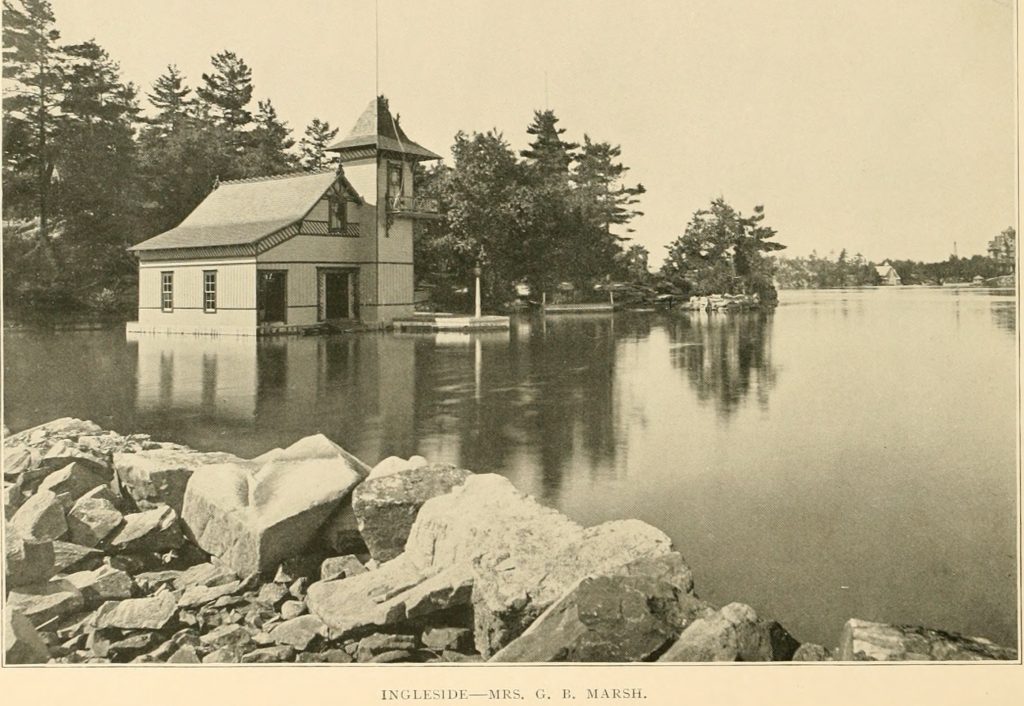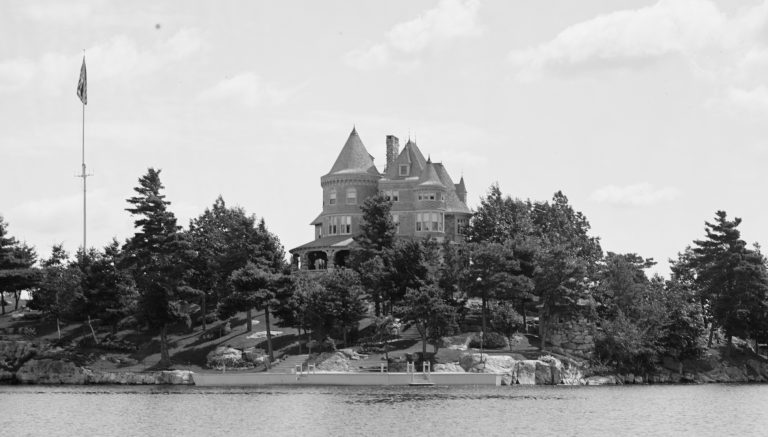James T. Easton Of Brooklyn Erects Stuyvesant Lodge On Cherry Island
Stuyvesant Lodge is another of the mid-1880s summer homes in the Thousand Islands that doesn’t appear to have much information in newspapers nor photographs in general to help recount its history. Built on Cherry Island, earlier known as Whortleberry Island which the local river rat Phat Boy explained in his book, 15 Years on the St. Lawrence, was due to its inhabitants growing their own strawberries, Stuyvesant Lodge was completed in 1886 for James T. Easton. The name “Stuyvesant” itself comes from Easton’s home address in Brooklyn, 414 Stuyvesant Ave.

The Watertown Daily Times in June of 1916 printed some of the earlier history of Cherry Island, stating–
Cherry Island was given to Rev. George Rockwell, who was then pastor of the Reformed church in this village, about 63 years ago, by Cornwall and Walton, who at that time owned nearly all the islands in the St. Lawrence in this vicinity.
Rockwell had actually struck a deal with Cornwall and Walton, who were cultivating the trees on the islands for timber, for the land provided he build a cottage on it. Rockwell eventually built what was known as Sunnyside near to where Stuyvesant Lodge was later located and the two co-existed for some time.

Other cottages on Cherry Island around the same time included G. B. Marsh’s Ingleside, where Nathan Straus later built his summer home next to business partner Abraham Abraham‘s, and Melrose Lodge, situated between Stuyvesant and Ingleside, which later became Casa Blanca.
Stuyvesant Lodge was described as a “good-sized and comfortable modern cottage” at the time, though Easton, who had a transportation firm of Easton and McMahon back in New York City, continued to make improvements to it and the land over the next several years.

One particular story of James T. Easton and his family sheds light on how different the times were back then without much in the way of communication other than letters. The Times printed in 1890 a story of Easton reuniting with a long-lost sister–
James Easton’s boyhood was spent on a farm in Oriskany. About 1836 he went to New York to live. His sister was then the happy bride of Henry Blinn, a young carpenter and builder of promise. Soon after Mr. Easton left home Mr. Blinn was offered a better position in Statford, Ohio. He went there with his young wife and bought a farm and all went well. Mrs. Blinn’s brothers heard from her frequently for about 25 years. Then communication ceased, and they lost track of her. Although they did not hear from both her brothers (the other being J. G. Easton of Waterville) supposed she was in comfortable circumstances.
James Eason took a vacation last week and decided to look his sister up. On going to Stratford he found his sister and brother-in-law had been unfortunate, lost all their property and gone from Strattford. Mr. Easton then pursued his search to Delaware, Ohio, and in an almshouse there found his sister by the bedside of her dying husband. He immediately made arrangements to have them removed to his home in Brooklyn, to spend the remainder of their days.
As Mr. Blinn was in such a critical condition they decided to wait a few hours. They had not long to wait, for he died that night. Mr. Easton returned to Brooklyn, where he is a wealthy and influential resident, and his sister will join him and make her home with him. J. G. Easton of Waterville is very ill and they dare not break to him the good news of the finding of his sister.

James T. Easton passed away in 1899 and the presumably ended up with Sarah Easton, unknown relationship, who sold it in 1913 to Nathan Straus. As reported in the Ogdensburg Journal that January–
Nathan Straus, a New York millionaire summer resident of the Thousand Islands, has purchased the remaining portion of Cherry Island, the deed having been filed at the county clerk’s office. The property was formerly owned by Mrs. Sarah Easton and consists of about three-eighths of an acre, one third of a mile southwest of Alexandria Bay. Mr. Straus has a magnificent home on Cherry Island.

Straus sold his cottage in 1916 to James Dawes as he had retired from business and dedicated the remainder of his life to philanthropy and charitable causes, much of which can be read on the Abraham Summer Home page. Straus, however, continued to own Stuyvesant Lodge for the remainder of his life though he frequented the Thousand Islands less in his later years, going for long periods of time between visits.
After Straus’s death in 1931,part of the estate on Cherry Island was sold by Nathan, Jr., executor of the estate, to the Ostrich Holding Company of New York for $5,000 in 1932. Presumably, this was the Stuyvesant Lodge. Unfortunately, no further information on it can be located and its been speculated that it either was razed or destroyed by fife between then and 1940. No information could be located on Ostrich Holding Company’s further dealings with the property, either.











